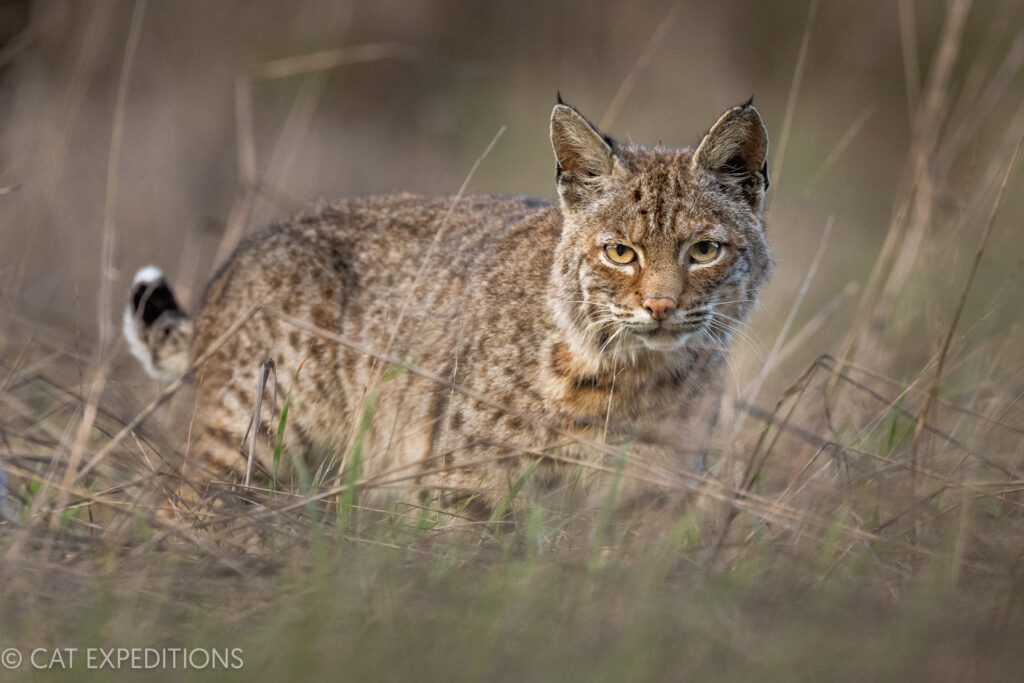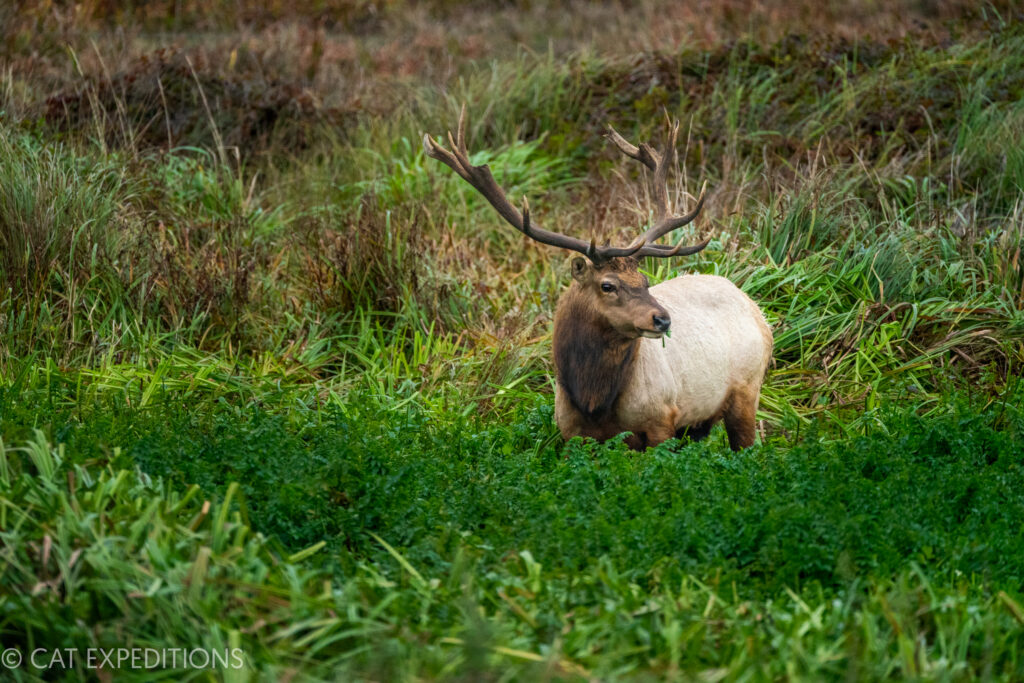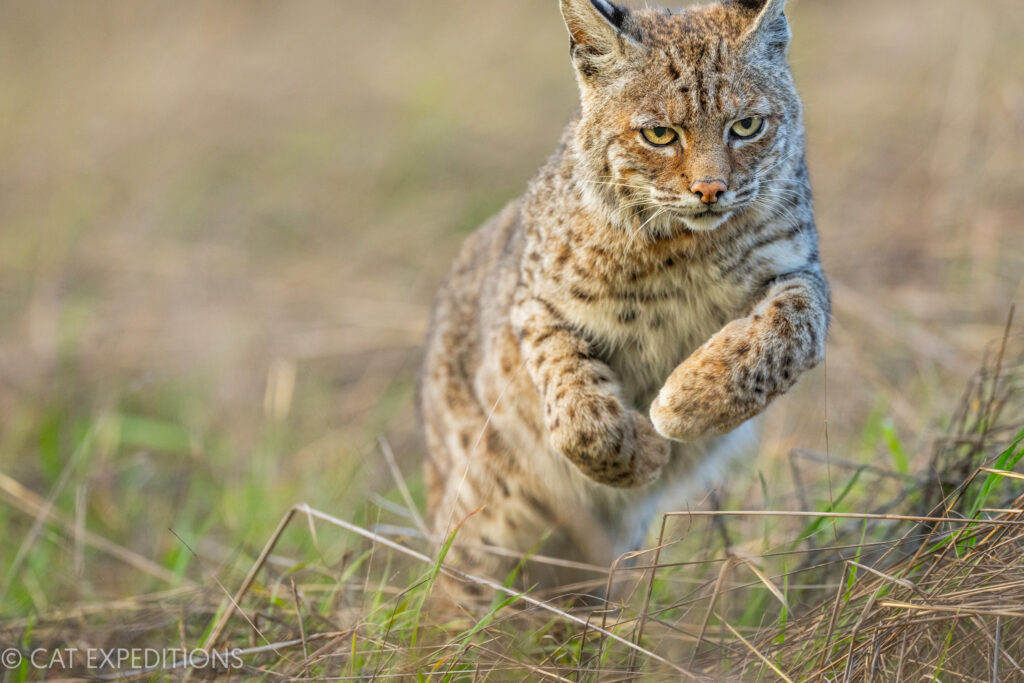In 2023, we led three different Bobcats of California photo tours in early December. Two of these tours were private. One of these trips was our best yet, as we had fifteen different bobcat sightings, blowing our previous record out of the water. Read on for our Bobcats of California Photo Tour 2023 Trip Report.

Highlights of the 2023 Bobcat Photo Tour
Bobcats: For the durations of the trips, we had at a minimum five bobcat sightings, and at a maximum fifteen (a new tour record). Sightings averaged twelve minutes, at an average distance of 25 meters. For our closest encounter the bobcat was two meters away!

Coyotes: As usual, there were too many coyotes to count. During each tour we were able to watch them hunt!

Tule Elk: Tule elk are a subspecies of elk, endemic to California. Though not hard to find, we always enjoy them! We had a nice moment with an elk browsing in a pond.

American Badger: In a tour first, for one of our trips, we had an incredible, extended sighting and encounter with an American Badger.

Bobcats of California Photo Tour Itinerary
Day 1: Arrival in San Francisco. Drive one hour to our hotel in southern Marin county. Settle in, go out for our first bobcat safari, dinner in Mill Valley.
Day 2: Morning bobcat safari in southern Marin, afternoon safari in west Marin.
Day 3: Morning and afternoon safari in west Marin.
Day 4: Morning bobcat safari in west Marin, afternoon safari in southern Marin. Dinner. Fly out.
Detailed Trip Summary of our 2023 Bobcat Photo Tour
Day 1: After picking up the guest in San Francisco, we headed north to Marin county. We settled into our hotel before going out for dinner. This trip would only be three and a half days, a whole day shorter than the usual tour, but the client had to fly onwards to New Zealand, so we told him we would do what we could. The time we had was some of the best we have ever had, with a total of fifteen bobcat sightings.
Day 2: After an early breakfast, we made our way to our western Marin location. The early morning around sunrise produced some nice hunting coyotes and tule elk sightings. Our first bobcat sighting came around 10:00am with a male about thirty yards away. He was hunting, but was unsuccessful, and moved on towards an area we couldn’t follow.

Our second cat was another male, one we know well. He’s not too fond of people so we didn’t try to get closer to him, knowing he’d run off into the bushes. Our third/fourth sighting was a female with her almost fully grown kitten. The allowed us about forty minutes with them before moving on. It was lunchtime and we just couldn’t stop being excited about how many cats we had seen. Normally I hope for that many cats for the duration of a tour! After lunch we spotted another shy male on two different occasions. It was great to see him, but with him being shy the sightings were at a distance. The final, and seventh, bobcat was a female hunting in a field. We followed her and had a nice, though quick session, before she moved on.

Day 3: With our very early breakfast in hand, we drove to our western marin location. The first cat appeared around 9am. We had spotted hher from about 700 meters away, but very slowly approached until we were only abut 15 meters away. It was just basking in the sun. He knew where we were, but didn’t care. After watching him for thirty minutes falling in and out of cat naps, he got up, groomed himself for a minute for two, and then walked away into cover. We saw two more bobcat females briefly, shortly after that.

Our best sighting of the day came in the late morning. We found a female that had just hunted a gopher, with her prey still wriggling in her mouth. She carried it over to a bush before dispatching it. We watched her eat it for a good twenty minutes. Then the necessary post-meal grooming session. All of a sudden she got very alert, trying to look over the bush and up the hillside (we were downhill of her). She ran off immediately into the bushes. We couldn’t see what she had smelled/seen. I kept looking for a coyote to pop up. We waited for thirty minutes or so to see if she could come back out.

Right when we were ready to leave, we spotted her on an adjacent hillside. We approached her and watched her as she attempted to hunt a rabbit (which got away). As she turned uphill, I was finally able to get a good look at her underparts, and this was definitely not a female, and therefor a different cat altogether. This male scen’t marked as it walked up the hill (both females and males do this), and then disappeared over the hill. As I looked down to see where I was stepping, I just glanced the head of a bobcat on the same hillside, but it couldn’t have been the male, as he was for sure already over the hill. This cat got up and I could see it was a female, she went over to smell the spots where the male had sprayed, and even smelled the spot where he had attempted to hunt. It was amazing to see all of this behavior. We paralleled her a bit, and then realized this was the female who we had just seen devour the gopher. As she walked across the hill, a second, smaller cat jumped out of the bushed and followed her. It was the same mother and kitten bobcat as from the day before! They disappeared into thick covers, but seeing that much behavior was incredible!
In the afternoon we went to a different location in Marin county where we had a special sighting of a female bobcat. When we encountered her, she was hunting. After that typical low horizontal jump, she caught a large gopher, ate it, and instead of grooming went right back to hunting. We ended up spending a total of over two hours with her before she too disappeared into thick brush.

Day 4: With fourteen sightings under our belt, out client was ready to try for different wildlife, than just bobcats, so we totally switched things up and went to a location in the Bay we have never taken guests. We had nice sightings of golden eagles flying near us, before another bobcat just had to show up and take out attention away from the birds. We watched this male for about thirty minutes, as he mostly sat, while half heartedly hunting. Our guest had an evening flight so we got him to the airport to fly to New Zealand! What an insane tour it was!

Species List for the Bobcat Photo Tour 2022
Mammals
| Brush Rabbit | Sylvilagus bachmani |
| California Ground Squirrel | Spermophilus beecheyi |
| Botta’s Pocket Gopher | Thomomys bottae |
| Coyote | Canis latrans |
| Gray Fox | Urocyon cinereoargenteus |
| Striped Skunk | Mephitis mephitis |
| Bobcat | Lynx rufus |
| American Badger | Taxidea taxus |
| Northern Elephant Seal | Mirounga angustirostris |
| Tule Elk | Cervus elaphus hispanicus |
| Mule Deer | Odocoileus hemionus |
Birds
| California Quail | Callipepla californica |
| Anna’s Hummingbird | Calypte anna |
| Killdeer | Charadrius vociferus |
| Semipalmated Plover | Charadrius semipalmatus |
| Snowy Plover | Charadrius nivosus |
| Whimbrel | Numenius phaeopus |
| Long-billed Curlew | Numenius americanus |
| Marbled Godwit | Limosa fedoa |
| Surfbird | Calidris virgata |
| Dunlin | Calidris alpina |
| Least Sandpiper | Calidris minutilla |
| Wilson’s Snipe | Gallinago delicata |
| Great Blue Heron | Ardea herodias |
| Great Egret | Ardea alba |
| Snowy Egret | Egretta thula |
| Turkey Vulture | Cathartes aura |
| White-tailed Kite | Elanus leucurus |
| Northern Harrier | Circus cyaneus |
| Sharp-shinned Hawk | Accipiter striatus |
| Bald Eagle | Haliaeetus leucocephalus |
| Red-shouldered Hawk | Buteo lineatus |
| Red-tailed Hawk | Buteo jamaicensis |
| Ferruginous Hawk | Buteo regalis |
| Barn Owl | Tyto alba |
| Great Horned Owl | Bubo virginianus |
| American Kestrel | Falco sparverius |
| Peregrine Falcon | Falco peregrinus |
| Acorn Woodpecker | Melanerpes formicivorus |
| Northern Flicker | Colaptes auratus |
| American Kestrel | Falco sparverius |
| Black Phoebe | Sayornis nigricans |
| Steller’s Jay | Cyanocitta stelleri |
| Western Scrub-Jay | Aphelocoma californica |
| American Crow | Corvus brachyrhynchos |
| Common Raven | Corvus corax |
| Western Bluebird | Sialia mexicana |
| White-crowned Sparrow | Zonotrichia leucophrys |
| Song Sparrow | Melospiza melodia |
| Red-winged Blackbird | Agelaius phoeniceus |
| Brewer’s Blackbird | Euphagus cyanocephalus |
